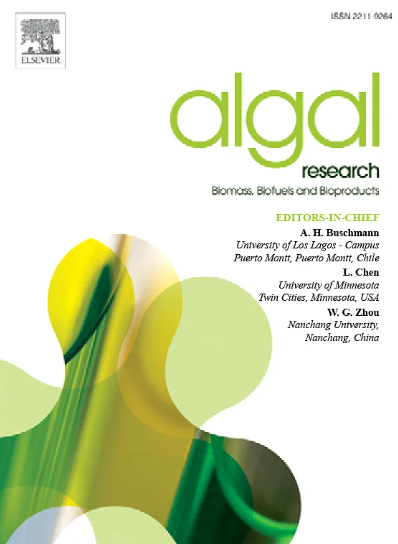一种新的Scenedesmus sp.菌株在不同盐度下同时去除海水养殖尾水中的氮和磷酸盐
IF 4.6
2区 生物学
Q1 BIOTECHNOLOGY & APPLIED MICROBIOLOGY
Algal Research-Biomass Biofuels and Bioproducts
Pub Date : 2025-05-28
DOI:10.1016/j.algal.2025.104115
引用次数: 0
摘要
微藻是去除水产养殖废水中氮和磷的一种极有价值的资源。然而,它们的生物量和养分去除效率受到有限的耐盐性的显著影响。本研究成功分离出一株具有良好盐度适应性的新菌株。生长分析表明,在盐度为0‰、5‰和10‰的条件下,培养12 d后,盐驯化的情景藻细胞密度分别为1.98 × 106、0.92 × 106和0.65 × 106细胞/mL,高盐度显著提高了蛋白质含量(15‰时为84.58%)、可溶性糖含量(20‰时为192.20%)和总脂质含量(15‰时为7.97倍)。叶绿素a含量最高达274.81%(10‰),关键光合参数(YII和Fv/fm)在高盐度条件下降低23.20 ~ 62.27%。在盐度为0‰时,微藻对NH4+-N的去除率为72.42%,对PO43−-P的去除率为94.30%;在盐度为10‰时,对NH4+-N的去除率为69.32%,对PO43−-P的去除率为76.35%。转录组学分析显示,盐度在10‰下诱导的差异基因表达主要影响光合作用相关途径(光捕获和反应)和能量代谢,这解释了在高盐度下观察到的营养物去除效率下降。这些生理和分子结合的发现为将功能性微藻应用于广盐养殖系统的污染物处理提供了有价值的见解。本文章由计算机程序翻译,如有差异,请以英文原文为准。
A novel Scenedesmus sp. strain performs simultaneous nitrogen and phosphate removal from mariculture tail water at different salinities
Microalgae represent a highly valuable resource for the removal of nitrogen and phosphorus from aquaculture effluents. However, their biomass production and nutrient removal efficiency are significantly influenced by the limited salinity tolerance. This study successfully isolated a novel strain of Scenedesmus sp. with remarkable salinity adaptability. Growth analysis showed that salinity-acclimated Scenedesmus sp. had cell densities of 1.98 × 106, 0.92 × 106, and 0.65 × 106 cells/mL at 0 ‰, 5 ‰, and 10 ‰ salinity after 12 days of culture, and high salinity significantly increased the contents of protein (84.58 % at 15 ‰), soluble sugar (192.20 % at 20 ‰), and total lipid (7.97-fold increase at 15 ‰) compared to freshwater condition. Moreover, photosynthetic efficiency exhibited salinity-dependent responses, with chlorophyll a content peaking at 274.81 % (10 ‰), while key photosynthetic parameters (YII and Fv/fm) showed 23.20–62.27 % reduction at high salinities. The microalgae could remove 72.42 % NH4+-N and 94.30 % PO43−-P at 0 ‰ salinity, and 69.32 % NH4+-N and 76.35 % PO43−-P at 10 ‰ salinity. Transcriptomic analysis revealed that salinity-induced differential gene expression at 10 ‰ salinity primarily affected photosynthesis-related pathways (light capture and reactions) and energy metabolism, which explains the observed decline in nutrient removal efficiency at higher salinities. The combined physiological and molecular findings provide valuable insights for applying functional microalgae in pollutant treatment of euryhaline aquaculture systems.
求助全文
通过发布文献求助,成功后即可免费获取论文全文。
去求助
来源期刊

Algal Research-Biomass Biofuels and Bioproducts
BIOTECHNOLOGY & APPLIED MICROBIOLOGY-
CiteScore
9.40
自引率
7.80%
发文量
332
期刊介绍:
Algal Research is an international phycology journal covering all areas of emerging technologies in algae biology, biomass production, cultivation, harvesting, extraction, bioproducts, biorefinery, engineering, and econometrics. Algae is defined to include cyanobacteria, microalgae, and protists and symbionts of interest in biotechnology. The journal publishes original research and reviews for the following scope: algal biology, including but not exclusive to: phylogeny, biodiversity, molecular traits, metabolic regulation, and genetic engineering, algal cultivation, e.g. phototrophic systems, heterotrophic systems, and mixotrophic systems, algal harvesting and extraction systems, biotechnology to convert algal biomass and components into biofuels and bioproducts, e.g., nutraceuticals, pharmaceuticals, animal feed, plastics, etc. algal products and their economic assessment
 求助内容:
求助内容: 应助结果提醒方式:
应助结果提醒方式:


